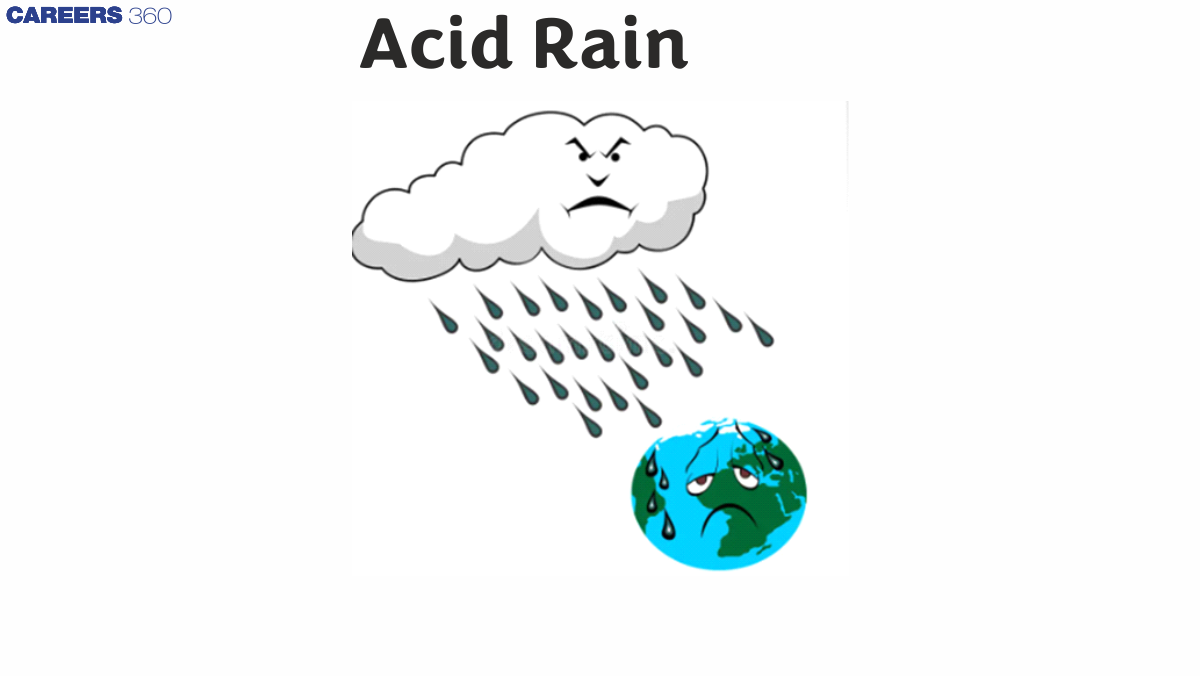Acid Rain - Meaning, Definition, Causes, Effects, Examples, FAQs
Acid rain is a precipitation that is more acidic than normal water, including rain, snow, fog, and dew that contain high levels of acidic components. As carbon dioxide gas combines with it to generate weak carbonic acid, regular rain is mildly acidic, with a pH of around 5.6. For example:
CO2 + H2O → H2CO3
There are two types of acidic deposition: wet and dry. Dry deposition of harmful particles and gases adheres to the ground through dust and smoke in the absence of precipitation.
As natural and unpolluted rainwater has a pH between 5.6 and 6.5 (acidic) due to the reaction of water with CO2, it is classified as acid rain when its pH is less than 5.6. The acidity of rainwater is caused by the natural presence of three compounds and acid rain (CO2, NOx, and SO2) in the troposphere, which are emitted through coal combustion in power plants and gasoline combustion in automobiles. Acid rain pH can range from 5.6 to 3.5, and in certain situations, it can even fall below 2.
NEET 2025: Mock Test Series | Syllabus | High Scoring Topics | PYQs
JEE Main: Study Materials | High Scoring Topics | Preparation Guide
JEE Main: Syllabus | Sample Papers | Mock Tests | PYQs
- What Causes Acid Rain
- Environmental Effects of Acid Rain
- Examples of Acid rain


What Causes Acid Rain
Mineral acids such as carbonic acid, nitric acid, and Sulphuric Acid are the principal causes of acid rain.
Acid rain causes
Carbonic acid is formed when carbon dioxide gas molecules react with water molecules (H2CO3). Carbonic acid's capability (H2CO3). The H2CO3 (carbonic acid) molecule possesses the potential to supply H+; because of this, the molecule is classified as an acid. As a result, it is in charge of reducing the pH of a solution.
CO2 + H2O → H2CO3
H2CO3 → H+ + HCO3-
The molecule of nitric oxide (NO), which is generated during lightning storms by the reaction of nitrogen and oxygen, two prevalent atmospheric gases, contributes to the natural decrease of pH (acidity) of precipitation. Nitric oxide (NO) is oxidized to nitrogen dioxide (NO2) in the air, which then reacts with water to form nitric acid (HNO3). In a reaction similar to the dissociation of carbonic acid indicated in the equation below, this acid dissociates in water to produce hydrogen ions (H+) and nitrate ions (NO3-), reducing the pH of the solution once more.
NO + ½ O2 (g) → NO2 (g)
N2 (g) + O2 (g) → 2NO (when lightning strikes in the atmosphere, a reaction occurs.)
3NO2 (g) + H2O → 2HNO3 (aq) + NO (g)
Nitric acid is responsible for around one-fourth of the pH drop in rain (HNO3).
The presence of sulphuric acid (H2SO4) in rainwater accounts for the reduction of pH in most water bodies. Despite the fact that sulphuric acid is produced naturally. Sulphuric acid is produced nearly completely by human activity, particularly the combustion of sulphur-containing fossil fuels in power plants. It is produced naturally in trace amounts through biological decomposition and volcanic activity.
Sulphur in these fossil fuels reacts with water to generate sulphuric acid when they are burned.
SO2 (g) + O2 → SO3 (g) + H2O → H2SO4
Sulphuric acid is an extremely powerful acid. As a result, it is regarded as a strong electrolyte that easily dissociates in water to produce H+ and HSO4- ions. The hydronium ion (H+) and sulfate ion may dissociate further from the HSO4- ion (SO42-) As a result of the presence of H2SO4, the concentration of H+ ions in the rainwater rises substantially, and the pH decreases to a dangerous level.
H2SO4 → HSO4- + H+
HSO4- → SO42-+ H+
Also read :
- NCERT notes Class 11 Chemistry Chapter 14 Environmental Chemistry
- NCERT Solutions for Class 11 Chemistry Chapter 14 Environmental Chemistry
- NCERT Exemplar Class 11 Chemistry Solutions Chapter 14 Environment Chemistry
Environmental Effects of Acid Rain
Acid rain increases the number of inorganic and biological reactions that have negative environmental consequences, resulting in a global environmental disaster.
Many huge lakes have become so acidic (low pH lakes) that fish can no longer survive in them.
The breakdown of many naturally occurring soil minerals produces metal ions. These metal ions are then swept away in the runoff, resulting in a variety of consequences:
a) The mobility of harmful ions such as Al3+ in the water supply increases due to the acidic situation.
b) The loss of essential minerals, such as Ca2+, from the soil in the process of neutralizing sulphuric acid, which generates a Ca2+ deficit, kills trees and damages crops.
It affects both animals and the Human respiratory system.
Acid rain has an impact on the aquatic ecosystem when it falls and runs into rivers and ponds. It creates water pollution by changing the chemical composition of the water to a state that is damaging to the aquatic ecosystem's ability to exist.
Corrosion of water pipes is also a result of acid rain. As a result, heavy metals such as iron, lead, and copper are leached into drinking water.
It causes damage to stone and metal structures and monuments.
NCERT Chemistry Notes :
Examples of Acid rain
Acid rain has a significant impact on the Taj Mahal, one of the world's seven wonders. Many companies in the city of Agra produce sulfur and nitrogen oxides into the atmosphere. People continue to utilize low-quality coal and firewood as a source of household energy, exacerbating the problem. Acid rain reacts with marble (Calcium Carbonate) in the following way:
CaCO3 + H2SO4 → CaSO4 + H2O + CO2
The corrosion of this lovely monument is caused by the production of calcium sulfate.
2. The Statue of Liberty, which is made of copper, has also been affected by the cumulative impact of acid rain and oxidation for over 30 years and is thus turning green.
Also, check-
Frequently Asked Questions (FAQs)
When molecules like sulphur dioxide and nitrogen oxides are released into the air, a chemical reaction occurs, resulting in acid rain. These contaminants can ascend very far in sky, where they combine which along with reaction with water, oxygen, as well as ther molecules to generate acid rain, which is a highly acidic kind of pollution.
Acid rain has greatest biological impact on coastal areas such as streams and other species can be toxic. As acidic precipitation travels through the soil and subsequently rushes into streams and lakes, it can leach aluminium from soil clay particles.
Alternative energy sources, such as solar and wind power, should also be used. As they produce far fewer emissions, renewable energy sources aid in the reduction of acid rain. Nuclear power, hydropower, and geothermal energy are examples of various electrical sources. Nuclear and hydropower have the most widespread use of them.
Sulphur dioxide and nitrogen oxide are the principal chemicals for acid rain. It also affects humans since the acid goes into fruits, vegetables and animals. In other words, one gets really sick if acid rain doesn’t stop, by eating those things.
Nitric oxide, nitrogen dioxide, sulphur dioxide, and sulphur trioxide are the primary gases that cause acid rain. Acid rain is caused by gases that cause the evaporation of nutrients from plants, causing harm to plant and leaves
Acid rain is a term used to describe any precipitation (rain, snow, fog) that has a higher acidity than normal, typically defined by a pH less than 5.6. It occurs when sulfur dioxide (SO₂) and nitrogen oxides (NOₓ), released into the atmosphere from burning fossil fuels and industrial processes, mix with water vapor and form sulfuric and nitric acids.
The primary causes of acid rain are emissions of sulfur dioxide and nitrogen oxides from human activities, such as burning coal, oil, and gas for energy, as well as emissions from vehicles and industrial processes. These pollutants react with water, oxygen, and other chemicals in the atmosphere to form acidic compounds.
Yes, acid rain can significantly damage buildings and structures, particularly those made of limestone, marble, and concrete. The acids can react with the minerals in these materials, leading to erosion and structural degradation over time.
No, acid rain contain weaker acid so they are not enough to burn the skin. strong acid will burn the skin if we touch them. Acid rain caise irritation to the skin but do not burn them.
Also Read
11 Mar'25 09:55 AM
09 Dec'24 11:41 AM
20 Oct'24 04:53 PM
20 Oct'24 11:38 AM
20 Oct'24 11:34 AM
20 Oct'24 11:13 AM
19 Oct'24 11:02 AM
30 Sep'24 08:56 AM
30 Sep'24 08:55 AM